The basic knowledge of coffee introduces the varieties of black coffee.
Aroma is not only the life of coffee quality, but also the best expression of coffee production process and roasting technology. The climate of the place of production, variety, refined treatment, harvest, storage, and the appropriateness of baking technology in the consuming country are all conditions that determine the aroma of coffee beans. Bitter is the basic taste of black coffee, there is a difference between strength and texture, raw beans contain only a tiny amount of bitter ingredients, followed by baked sugar, part of starch, fiber caramelization and carbonization, to produce the most symbolic bitterness of coffee. Black coffee also has a sour taste, and proper heat to produce a moderate sour taste will make the coffee taste better and make people feel more deep. The sweetness of black coffee is closely related to the bitter taste, so the refreshing black coffee must have a sweet taste.

Coffee beans are the raw materials of black coffee, there are hundreds of kinds, and the price varies according to the variety, origin and grade. At present, we are familiar with Blue Mountain, Italy, Mantenin, Brazil, charcoal roast and other kinds in Beijing, which can be bought in many supermarkets, most of which are baked ripe beans. Due to different producing areas, the characteristics of coffee beans are also different, some of the color is dark, the degree of baking is higher, the taste is thicker; some are lighter in color and slightly lighter in taste. The expert candidate for coffee is to grab a handful of coffee beans to see whether the color of each bean is the same and whether the particles are similar in size and shape, so as to avoid buying shoddy products disguised as mixed beans. In addition, if the baked beans out of oil, it has gone bad, not only reduced aroma, but also astringent and sour taste.
Most people who like black coffee make it at home. On the small square, there are several necessities for production, and the process is like the Chinese tea ceremony. People who pay attention to sentiment will buy back a bean grinder, grind slowly at home and enjoy the process of falling in love. At present, the better bean grinders are mostly produced in Japan and Taiwan, there are manual and electric, manual bean grinders are mostly antique, the price is one or two hundred yuan. But there are also more expensive, such as the size of coffee powder can be adjusted through the spring or the most popular two-wheel appearance of fashion products, ranging from 300 yuan to more than 600 yuan.
There are three ways to make black coffee, so there are three different types of coffee pots: traditional follicle type, siphon type and electric type. The traditional follicle style is the most primitive and the simplest way to do it. The coffee pot is composed of a funnel, a piece of filter paper and a container below, but it requires high manual craftsmanship. If you handle it properly, you can make delicious coffee with a mellow taste. The price of this kind of pot is so cheap that you can buy it for more than ten yuan. The follicular coffee pot is suitable for coffee tasters with stable handle and keen taste. When buying follicular coffee utensils, pay attention to whether it is three holes or one hole, which is very important. The dripping speed of three holes is faster, the extraction time is short, the coffee is lighter, and the opposite is true for one hole.
Although the traditional follicle style is the simplest, it is the coffee pot that can best brew the original flavor of coffee. In the production process, it is necessary to accurately grasp the water temperature, water flow size and trajectory. A uniform flow and a round track can make the coffee taste natural, so the choice of the kettle and the control of pouring water with both hands are very important. When the water comes into contact with the coffee, it should be kept round as far as possible, from the outside to the inside, from the inside to the outside, so that the coffee is in full contact with the current. At the same time, the water temperature of 92 degrees Celsius can make the coffee fragrant, mellow, sweet, sour, bitter uniform and strong, too high water temperature will scald the coffee, making the taste sour and astringent; if it is too low, it is difficult to brew the aroma of the coffee.
Important Notice :
前街咖啡 FrontStreet Coffee has moved to new addredd:
FrontStreet Coffee Address: 315,Donghua East Road,GuangZhou
Tel:020 38364473
- Prev

Common Coffee Tree Diseases and pests and Control methods in Coffee planting
1. Coffee tiger longicorn beetles are distributed in all coffee producing areas in the world, and also occur in Yunnan, Guangxi and Hainan Island in China. It is one of the major pests of coffee. The coffee tiger longicorn beetle harms the coffee trunk for more than 2 years. At first, it eats between the cambium and xylem, and then eats the xylem. The victim was a curved tunnel filled with sawdust, which had a great impact on coffee.
- Next

Special words for coffee bean grinding terminology for coffee bean grinding
Caffeine: caffeine is the most eye-catching of all the ingredients in coffee. It is a kind of phytoxanthin (animal muscle component). It has the same properties as theobromine contained in cocoa, green tea contains the same theophylline, and the percentage of reduction after baking is very small. Caffeine has a very wide range of effects. will affect the human brain, heart, blood vessels, gastrointestinal, muscle and kidney and other parts, the right amount of caffeine
Related
- Beginners will see the "Coffee pull flower" guide!
- What is the difference between ice blog purified milk and ordinary milk coffee?
- Why is the Philippines the largest producer of crops in Liberia?
- For coffee extraction, should the fine powder be retained?
- How does extracted espresso fill pressed powder? How much strength does it take to press the powder?
- How to make jasmine cold extract coffee? Is the jasmine + latte good?
- Will this little toy really make the coffee taste better? How does Lily Drip affect coffee extraction?
- Will the action of slapping the filter cup also affect coffee extraction?
- What's the difference between powder-to-water ratio and powder-to-liquid ratio?
- What is the Ethiopian local species? What does it have to do with Heirloom native species?

